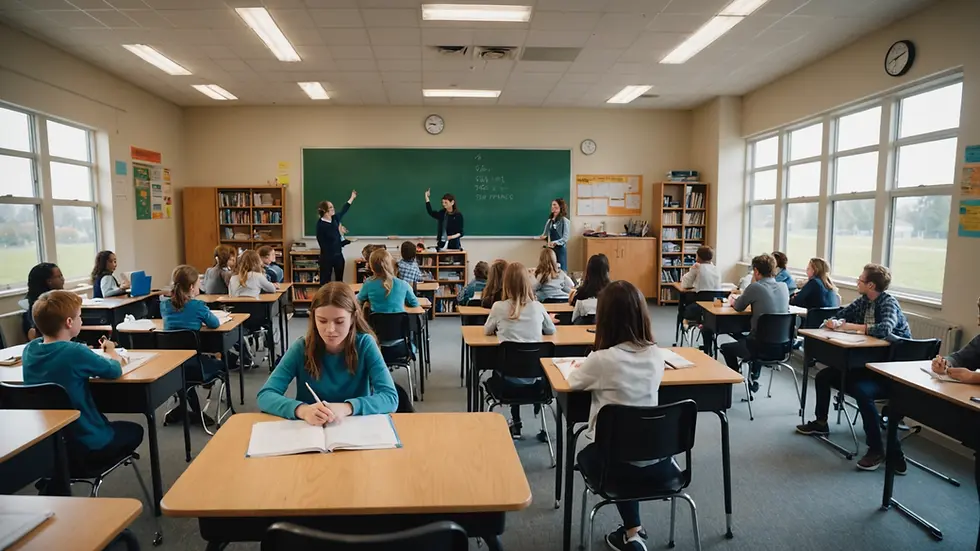Real Talk: Changing Teachers Can Negatively Affect Learning. Here's how!
- tovahstutoringcomp
- Feb 25
- 4 min read
How many years have you been working at your current job? Could you imagine having to start again - somewhere else - every year? New work mates, new tasks, new staffroom, new boss...the list goes on.
That's what children feel like in school. They enrol in different classes every year, build trusting relationships with their peers, get to know their teacher and the rules - all while learning on the job - only to changes classes the following year. It's tough for them. Not only are they expected to get used to their new environments, but they are also expected to perform well. I don't know about you, but for me, it takes me a few weeks to build collegial relationships and confidently know the ropes, and for students by a few weeks in, they are usually nose deep into their first assessment for the year. So surely, that would take a toll on their ability to deliver satisfying results.
This blog dives into how changes in teachers affect students, looking at the ups and downs that both students and teachers go through during these transitions.

But first, here's some factors that can affect academic performance...
Some factors can include:
No longer with any of their friends
The class is louder or more disruptive than last year
The teacher's expectations are higher or lower than their former teacher e.g. no consequences, silent classroom, strict consequences, line up outside before entering vs relaxed atmosphere
The teaching approach differs e.g. more practical, likes to have open discussions with their class, book work or note taking heavy, group work focused vs individual work
The teacher's skill levels differ to the former teacher e.g. more confident teaching a different area within the subject such as film study or essay writing, can explain clearly or are confusing/vague with their instructions, the teacher's voice is hard to understand (pace, pitch, volume etc.)
The upkeep and conditions of the learning environment change e.g. messy, old, cold, dark, uninviting, smells odd, cramped
This isn't a dig on teachers. I have been one for thirteen years and have developed my practice through trial and error. It is important to know that sometimes there are aspects within a classroom that can either add to or remove successful learning opportunities.
It's tough for them. Not only are they expected to get used to their new environments, but they are also expected to perform well.
Let's delve more into the experience, the emotional and social adjustments, the process of learning, and how to embrace change.
The Teacher Transition Experience
When students switch teachers, they encounter new teaching styles, classroom rules, and personal connections. Each teacher offers unique methods, emotional intelligence, and philosophies, which can disrupt students' learning momentum and require adjustment. For example, a student thriving with a hands-on teacher may struggle with one who prefers to teach using slideshows. Many students feel lost when adjusting to a new teacher, which you may find is similar to starting a new job with its own learning curves.
Each teacher offers unique methods, emotional intelligence, and philosophies, which can disrupt students' learning momentum and require adjustment.
Emotional and Social Adjustments
Students facing a teacher change experience a mix of excitement, anxiety, and apprehension, similar to adults changing jobs. Building rapport is crucial for both, as students assess which teachers understand and inspire them. Research shows that positive teacher-student relationships enhance educational outcomes, with a 2019 study indicating a 15% higher score in standardised tests for students with strong teacher connections. Understanding new personalities and teaching methods helps students find support, essential for their growth.
Students facing a teacher change experience a mix of excitement, anxiety, and apprehension, similar to adults changing jobs.
The Process of Learning
Learning requires adaptation in dynamic environments. Students must align their strategies with various teaching methods, and adults need to adjust their approaches across different teams, tasks, and workplace cultures. This adaptability develops cognitive flexibility, allowing students to approach problems differently and enhancing resilience, collaboration, and creative problem-solving in professional settings.
Embracing Change for Growth
Changing teachers significantly impacts student learning, similar to adults starting new jobs. Both require adaptability, emotional awareness, and clear communication. Strong educator-student relationships during transitions create a supportive learning environment, enhancing educational outcomes.
In conclusion, there are so many factors as to why students need additional support with their learning. It is so important to be aware of the changes that occur each year for students. Encouraging them to embrace change in their classrooms should foster growth. Just like in a new work environment that takes a bit of time to adjust to new protocols and procedures, students need adjusting to their new classrooms each year.
But let's not do this alone - student and worker alike. Engage positively with new colleagues or teachers as it offers valuable learning experiences and fresh opportunities for all.
Tovah's Tutoring Can Save the Day!
If your child is struggling to adjust to their new classroom, our expert tutoring services can ease the pressure and give them a boost towards knowing what to do.
As we are expert tutors and teachers, we know what is required at each year level. So, while your child is adjusting to their new learning environment, they can catch up and make sense of their learning in the comfort of their own homes.
Book here:
All the best,
Tovah O'Neill
Tovah's Tutoring Company Ltd






Comments